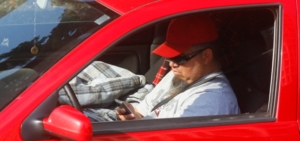Steve Wallace: Cellphones a boon and bane for drivers

A driver uses a cellphone while driving in Los Angeles. Cellphones are equally distracting behind the wheel whether handheld or hands-free, Steve Wallace writes.
One of the best communication devices ever invented is the cellphone. Do the positives of the cellphone far outweigh the negatives? How should the device be used by drivers? Recently passed provincial legislation, including increased penalties for improper use behind the wheel, has brought the matter to the fore.
There is no doubt about the feeling of better personal safety when one is in the possession of a mobile phone. People being threatened can report their location, and the nature of such a situation, to relevant authorities. It can be used to report a crash and bring help for those injured much faster than in the past. It is a good way to tell others of one’s location, if lost or confused about an intended destination. Its function goes well beyond various emergency situations: It is a simple convenience, as well as a good way to stay in touch with family and friends, employers and employees in real time.
People get lost. They can find their way to familiar locations or their destination, with the use of a cellphone. Personal experience in the matter has made me very appreciative to be able to converse with another, guiding me to or away from a location.
Years ago, in Prince George, a dangerous chlorine gas leak at a manufacturing facility produced a giant cloud. I was about to drive in its direction, when the cellphone rang, and a panic-stricken office staffer told me to drive quickly in the other direction. Pronto! Saved by the car phone!
Cellphones are equally distracting whether handheld or hands-free. It was a purely political decision that resulted in the present law of hands-free exemption. It is estimated that about one third of all traffic deaths are a result of distracted driving, many involving a communication device. Recent stiffer penalties and policies concerning cellphone use have been both enacted and enforced.
Drivers using the handheld option are putting themselves, their passengers and others at risk of serious injury or worse. This behaviour should only be reserved for instances of life-and-limb threat, for which there is a present legal exemption. Some persons in authority have suggested the phone be placed in the glove compartment or back seat. I respectfully disagree: It should be in a holder or in voice-activated mode and used in only emergency situations. Pulling over to make an important call is now the legal way to use a handheld device. Shutting the vehicle off is recommended by police, when the vehicle is parked at the side of the road with the handheld phone in use.
Several recent cases are making their way through the appeals process in our legal system. Is it right that an asthma sufferer gets charged and convicted for retrieving her puffer and phone, which had slipped off the front seat onto the floor of the vehicle when she stopped at a red light? Are drivers permitted to charge their cellphones when not using an affixed holder? Apparently not, given recent charges levied against supposed offenders. If the face of the stationary phone, not in an affixed holder, is visible to the driver, the charge is deemed to be legit. The operational face of a non-affixed phone should not be visible to a driver, while charging or otherwise, while the vehicle is operational.
Stay tuned, this process is ongoing and will become clearer to all of us as various cases wind their way through the courts.
Steve Wallace is the owner of Joan Wallace Driving School on Vancouver Island. He is a former vice-president of the Driving Schools Association of the Americas, a registered B.C. teacher and a University of Manitoba graduate.


